
On the winter mountains I am a jack-of-all-trades (and a master of none), dividing my time between straightforward hill walks, classic mountaineering, and slightly harder winter climbs. For anything below mid-grade climbs, and that's perhaps two out of every three days I spend on the hill, I swap more technical climbing-oriented crampons for a souped-down model, something that's better for simply walking.
Most hill-goers need an all-rounder in their life - a 4x4 of crampons, if you like, that's built for everything from winter Munro bagging through to mountaineering in the lower grades. This is the realm of the classic 12-point crampon.
But not all 12-pointers are identical. Some might have the edge on steeper ground, while others are slightly better for walking in. If you're carrying them as much as wearing them, they need to fold down small and be reasonably lightweight. But at the same time they should be robust. After all, on a single day in the British hills you'll often encounter very mixed conditions, from wet snow to solid neve; sheets of ice to verglassed rocks; frosted grass to gravel and scree. It's hard on the crampons.
Though it looks a little funkier than some more traditional alternatives, the Grivel Air Tech has been designed very much with this do-it-all approach in mind. So how did it fare?
Fitting
The bar linking the two parts of the crampon is cut in a pronounced curve, giving the Air Tech quite an assymmetric shape that matches well with most modern mountain boots. These are semi-rigid crampons, and should ideally only be paired with B2 or B3 boots.
As with the Grivel G12, the Air Tech is available with three different binding systems. These are not interchangeable, so you have to decide which suits you best:
New Classic A full strap-on with plastic heel and toe cradles, this is held on only by its straps. While it suits the greatest variety of boots, including those with no heel or toe welt, it is a little more fiddly to fit.
Newmatic A semi step-in with a plastic toe cradle and a clip-in heel binding, this requires boots with a heel welt but not necesarily also a welt at the toe (some B2 and most B1 boots are built like this). It is quick and easy to fit, and equally secure on full B3 mountain boots. This strikes me as the most versatile system, so given the all-rounder remit of the review it's the one I decided to cover here.
Crampomatic A full step-in model with a metal toe bail and plastic heel clip, this gives a good tight fit - but only on fully rigid B3 boots. I feel this binding system is overkill for a crampon with the modest climbing ambitions of the Air Tech. Unless, perhaps, you're fitting it to a ski touring boot?
The standard Air Tech fits boots size EUR 35-46, while a longer linking bar is available (ask when ordering) to take you up to 49 or 50 depending on the boot. But for me at least the fitting seems to depend more on their width than their length. At the front of the New Classic and Newmatic versions of the Air Tech the metal brackets onto which the toe cradle attaches are set quite close together, as are the metal horns that hold the heel in place on all versions. As a result, if your boot soles are wider than average then you may have a problem. I've a pair of Meindl B1 winter walking boots that are simply too wide to fit them, and the same issue with B2 Berghaus Kibos. On the two B3 boots in my gear stash, Salewa Vertical Pros and Mammut Mamook GTX, the fit is incredibly snug - in a good secure way, but only just! I would suggest trying these crampons with your own particular boots in the shop. But then you should always do that anyway.
Climbing versus walking
Having used the same pair for about 20 years (now retired) I guess I count as a fan of the Grivel G12, arguably the benchmark 12-point crampon. But although they have been on plenty of hill walks with me this model is at the climbing end of the all-rounder spectrum, with long front points, long forward-pointing secondary points and a fair old weight overall (good on ice climbs; less so when you're just walking).
In something of a contrast the Air Tech is lighter and its secondary points less aggressively angled. This may make it less of a climbing specialist, but it is still perfectly capable on lower grade winter routes. I've found the Air Tech copes well both on the rocky grade II mixed ground of classic Scottish ridge traverses, and on easy ice. The long, sharp front points feel precise on edges and give good penetration in hard ice. However with secondary points that angle downwards more than forwards, there's less purchase and stability for front pointing when the going gets steeper. It's not an exact science, but I'd probably draw the line at grade III ice.
In compensation for its slightly toned-down climbing performance the Air Tech is better than the G12, and many similar models, to simply walk in. The crucial distinction here is that all the points underfoot are significantly shorter, which makes the Air Tech feel less precarious and ankle-twisty when you're skittering over rocks. As a result I've found there can be quite a difference in how pleasant it feels to walk in (terrain depending), which for me really bolsters the Air Tech's appeal as a jack-of-all-trades.
The third set of points are smaller than the rest and set wider apart. Grivel's logic is that these engage only when you're traversing, on the basis presumably that you don't need all 12 points in action when walking on shallower slopes. I have to admit the mechanics of this arrangement rather escape me. The fourth set of points are interesting, cut with a right-angled cross section so that they bite both when going straight up or down the slope, and when travelling perpendicular to it.
Anti balling plates
To help resist snow balling dangerously underfoot in heavy wet conditions the Air Tech comes supplied with Grivel's excellent 'Antibott' plates, rubber sheets with a little springy blister that pushes out balled-up snow from between the crampon spikes. In my experience these work extremely well, and last longer than might be expected. An old set on a different pair of Grivel crampons are still going strong after several years of reasonably heavy use. Also supplied are rubber 'accordions', which fit over the linking bar to help resist balling under the mid foot.
Weight, packability and robustness
At 960g a pair, including anti-balling plates and accordions (these account for about 100g of the total weight), the Air Tech is roughly 100g lighter than Grivel's G12, and compares pretty favourably with models from other manufacturers. For packing they collapse fairly small, about 24cm long, or 27cm with the rubber accordions fitted on the linking bars. To save a little weight you could remove the anti-balling rubber bits, but for safety I'd rather keep them on all the time. In terms of lightness the Air Tech treads a sensible middle ground, with enough weight behind them to penetrate hard ice and a good robust overall construction. Made of chromolly steel, the points feel reassuringly durable and I've yet to blunt them significantly after several outings in fairly thin snow with plenty of scraping on rocks. The anodising is beginning to wear a little at the sharp ends, but I can't say that's a concern.
Made, say Grivel, from the most durable plastic available (developed for ski bindings), the cradles on the New Classic and Newmatic models are confidence inspiring, and should offer years of service. If they ever get to the point of looking worryingly worn, Grivel can fit replacemets.
It's worth noting that Grivel also make an Air Tech Light in super lightweight alloy. This is a pretty niche bit of kit primarily of interest to ski tourers - it won't long stand the hard knocks of UK hillwalking and general mountaineering.
Summary
You'll find lighter 12-point crampons; you'll find more aggressive climbing-oriented ones; and you could certainly pay a bit less for a pair. But for the average UK hill-goer in search of something versatile the Grivel Air Tech is agood well-built compromise between weight versus durability, and climbing performance versus walking comfort. From snowy fell walks to mountaineering ridge traverses, easier Scottish winter gullies to classic Alpine routes, they are a solid choice.
Grivel say
'Ten points in contact with ice while youre walking, 12 that bite into the slope during traverses. This has been made possible because the third pair of points are shorter and wider apart. On top of this the last two front points have a double angulation to maintain bite when descending or traversing sideways.'
'The crampons points are short and designed for the new requirements of mixed moderns alternating ice and rock. Sharp points are ideal for anchoring on ice cauliflowers and when in traction or adherence. Even the soles of the most modern boots are perfectly covered.'
'The Air Tech is a semi-rigid model in one adjustable size, the bar can be regulated by hand, in two different lengths and this new version has a new binding made in bi-components giving greater efficiency and lightness.'
'It is really an all seasons crampon, very light and takes up a minimum of space as it folds up completely on itself.'



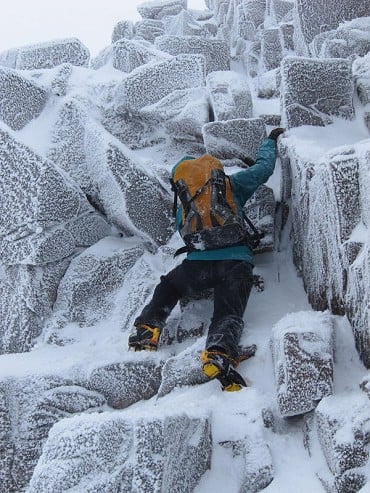
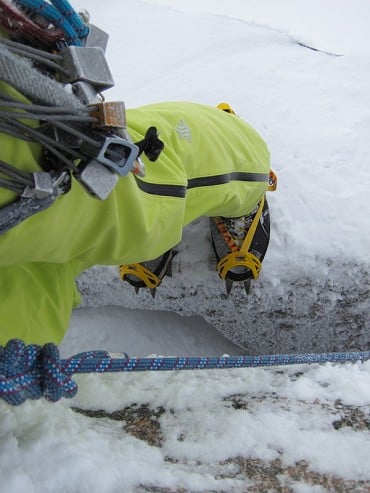




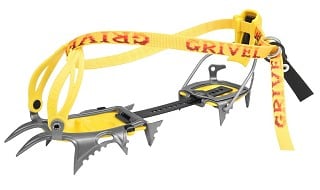


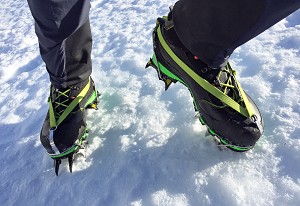
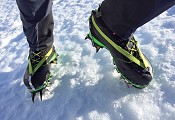
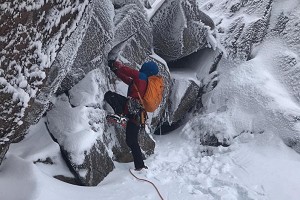
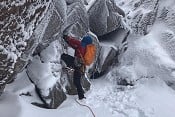
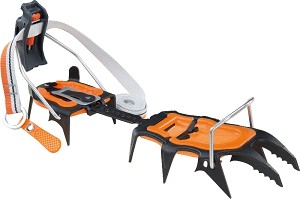
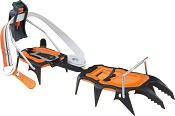





Comments